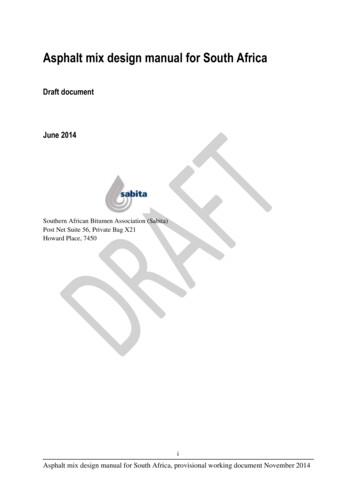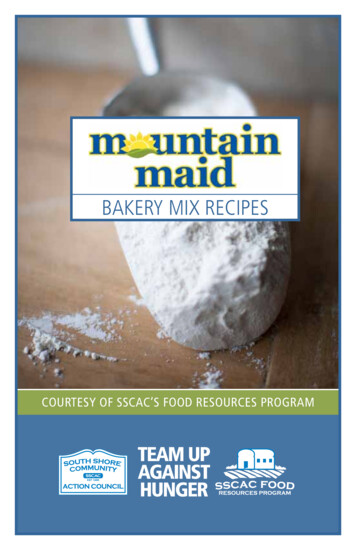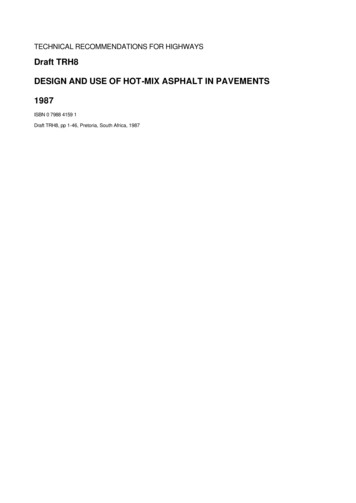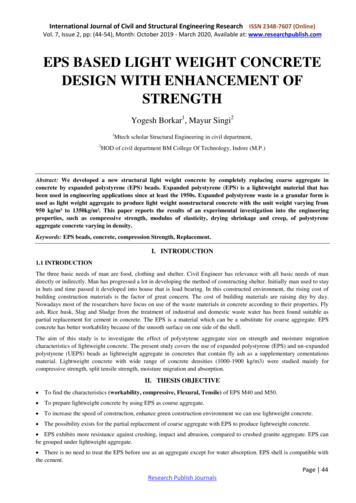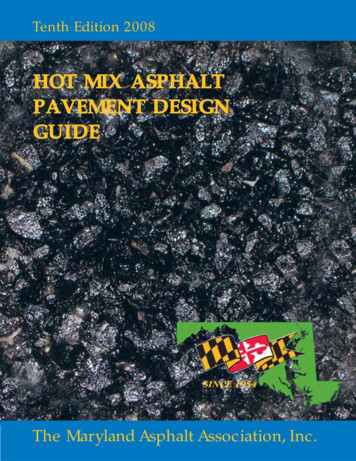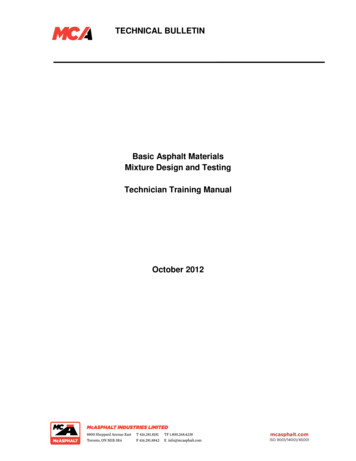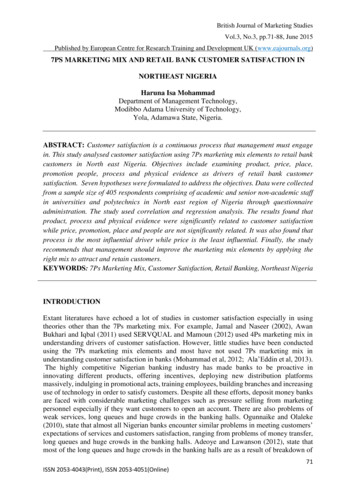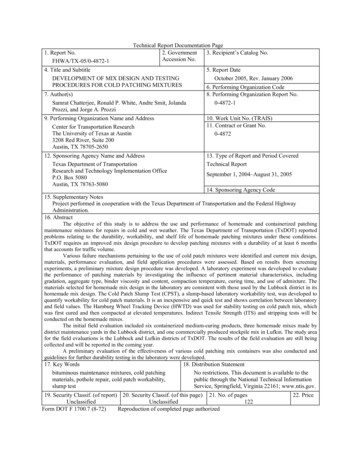
Transcription
1. Report No.FHWA/TX-05/0-4872-1Technical Report Documentation Page2. Government3. Recipient’s Catalog No.Accession No.4. Title and SubtitleDEVELOPMENT OF MIX DESIGN AND TESTINGPROCEDURES FOR COLD PATCHING MIXTURES5. Report DateOctober 2005, Rev. January 20067. Author(s)Samrat Chatterjee, Ronald P. White, Andre Smit, JolandaProzzi, and Jorge A. Prozzi6. Performing Organization Code8. Performing Organization Report No.0-4872-19. Performing Organization Name and AddressCenter for Transportation ResearchThe University of Texas at Austin3208 Red River, Suite 200Austin, TX 78705-265010. Work Unit No. (TRAIS)11. Contract or Grant No.0-487212. Sponsoring Agency Name and AddressTexas Department of TransportationResearch and Technology Implementation OfficeP.O. Box 5080Austin, TX 78763-508013. Type of Report and Period CoveredTechnical ReportSeptember 1, 2004–August 31, 200514. Sponsoring Agency Code15. Supplementary NotesProject performed in cooperation with the Texas Department of Transportation and the Federal HighwayAdministration.16. AbstractThe objective of this study is to address the use and performance of homemade and containerized patchingmaintenance mixtures for repairs in cold and wet weather. The Texas Department of Transportation (TxDOT) reportedproblems relating to the durability, workability, and shelf life of homemade patching mixtures under these conditions.TxDOT requires an improved mix design procedure to develop patching mixtures with a durability of at least 6 monthsthat accounts for traffic volume.Various failure mechanisms pertaining to the use of cold patch mixtures were identified and current mix design,materials, performance evaluation, and field application procedures were assessed. Based on results from screeningexperiments, a preliminary mixture design procedure was developed. A laboratory experiment was developed to evaluatethe performance of patching materials by investigating the influence of pertinent material characteristics, includinggradation, aggregate type, binder viscosity and content, compaction temperature, curing time, and use of admixture. Thematerials selected for homemade mix design in the laboratory are consistent with those used by the Lubbock district in itshomemade mix design. The Cold Patch Slump Test (CPST), a slump-based laboratory workability test, was developed toquantify workability for cold patch materials. It is an inexpensive and quick test and shows correlation between laboratoryand field values. The Hamburg Wheel Tracking Device (HWTD) was used for stability testing on cold patch mix, whichwas first cured and then compacted at elevated temperatures. Indirect Tensile Strength (ITS) and stripping tests will beconducted on the homemade mixes.The initial field evaluation included six containerized medium-curing products, three homemade mixes made bydistrict maintenance yards in the Lubbock district, and one commercially produced stockpile mix in Lufkin. The study areafor the field evaluations is the Lubbock and Lufkin districts of TxDOT. The results of the field evaluation are still beingcollected and will be reported in the coming year.A preliminary evaluation of the effectiveness of various cold patching mix containers was also conducted andguidelines for further durability testing in the laboratory were developed.17. Key Wordsbituminous maintenance mixtures, cold patchingmaterials, pothole repair, cold patch workability,slump test18. Distribution StatementNo restrictions. This document is available to thepublic through the National Technical InformationService, Springfield, Virginia 22161; www.ntis.gov.19. Security Classif. (of report) 20. Security Classif. (of this page) 21. No. of pagesUnclassifiedUnclassified122Form DOT F 1700.7 (8-72)Reproduction of completed page authorized22. Price
Development of Mix Design and Testing Proceduresfor Cold Patching MixturesSamrat ChatterjeeRonald P. WhiteAndre SmitJolanda ProzziJorge A. ProzziCTR Research Report:0-4872-1Report Date:October 2005, Rev. January 2006Research Project:0-4872Research Project Title:Material Design and Testing Methods for Home Madeand Containerized Cold MixSponsoring Agency:Texas Department of TransportationPerforming Agency:Center for Transportation Research at The University of Texas at AustinProject performed in cooperation with the Texas Department of Transportationand the Federal Highway Administration.
Center for Transportation ResearchThe University of Texas at Austin3208 Red RiverAustin, TX 78705www.utexas.edu/research/ctrCopyright (c) 2006Center for Transportation ResearchThe University of Texas at AustinAll rights reservedPrinted in the United States of Americaiv
DisclaimersAuthor’s Disclaimer: The contents of this report reflect the views of the authors, whoare responsible for the facts and the accuracy of the data presented herein. The contents do notnecessarily reflect the official view or policies of the Federal Highway Administration or theTexas Department of Transportation (TxDOT). This report does not constitute a standard,specification, or regulation.Patent Disclaimer: There was no invention or discovery conceived or first actuallyreduced to practice in the course of or under this contract, including any art, method, process,machine manufacture, design or composition of matter, or any new useful improvement thereof,or any variety of plant, which is or may be patentable under the patent laws of the United Statesof America or any foreign country.Notice: The United States Government and the State of Texas do not endorse products ormanufacturers. If trade or manufacturers’ names appear herein, it is solely because they areconsidered essential to the object of this report.Engineering DisclaimerNOT INTENDED FOR CONSTRUCTION, BIDDING, OR PERMIT PURPOSES.Project Engineer: Jorge A. ProzziP. E. Designation: Research Supervisorv
AcknowledgmentsThe authors acknowledge the TxDOT project monitoring committee, especially the projectdirector, Mr. Tracy Cumby (LBB), for their technical input during the progress of the project. Theauthors express their appreciation to the maintenance division crews of Lubbock and Lufkin districtsfor their contribution in field installation and field subjective ratings of various containerizedpatching materials.Also appreciated is the involvement and support of the manufacturers of the cold patchmaterials for donating the products used for testing in this research project (in alphabetical order):Asphalt Patch, Perma Patch, Proline, QPR, Stayput, Unique Paving Materials (UPM). Specialthanks also go to Valero Marketing for donating asphalt binder and Vulcan Materials and RE Janesfor donating aggregates. This research was performed in cooperation with the Texas Department ofTransportation and the Federal Highway Administration.vi
Table of Contents1. Introduction. 11.1 Background and Problem Statement.11.2 Objectives .21.3 Research Scope .21.4 Report Organization.32. Literature Review . 52.1 Failure Symptoms and Mechanisms .52.2 Factors Affecting Mix Design .62.3 Desirable Performance Requirements .72.4 Current Mix Design Challenges .92.5 Concepts for Improved Mix Design .102.6 Previous Studies.122.7 Current Mix Design in TxDOT Districts.182.8 Performance Testing Procedures .222.9 Field Maintenance Procedures.223. Development of Mixture Design Procedure . 253.1 Experimental Design.253.2 Preliminary Mixture Design Procedure .274. Laboratory Testing of Patching Materials . 314.1 Gradation Analyses and Aggregate Screening .314.2 Binder Testing.324.3 Curing Analysis .334.4 Superpave Gyratory Compaction Results.344.5 Workability Assessments.354.6 Wheel Tracking Tests .514.7 Indirect Tensile Strength Testing.524.8 Stripping Tests .525. Field Evaluation of Patching Mixture Performance. 535.1 Development of Field Patching Process .535.2 Test Sites and Materials Used.555.3 Data Collection Protocol.565.4 Condition Survey Protocol.585.5 Field Performance Evaluation .606. Preliminary Evaluation of Cold Patching Mix Containers. 616.1 Packaging of Containerized Patching Materials.616.2 Performance Evaluation of Containers .617. Summary and Conclusions. 637.1 Literature Review .637.2 Development of Mixture Design Procedure .667.3 Laboratory Testing of Patching Materials .67vii
7.4 Field Evaluation of Patching Mixture Performance .707.5 Preliminary Evaluation of Cold Patching Mix Containers .71References. 73Appendix A: TxDOT Specification . 77Appendix B: TxDOT’s Function Code 241 . 79Appendix C: Technical Memorandum No. 1 (Experimental Design). 81Appendix D: Technical Memorandum No. 2 (Assessment of Candidate RoadSections for Field Trials). 89Appendix E: Patch Condition Survey Manual. 107Appendix F: Field Installation and Condition Survey Pictures from Lubbock and LufkinDistricts. 109viii
List of FiguresFigure 2.1 Gradation Curves for Containerized and Homemade Mixtures . 19Figure 3.1 Gradation Curves of Aggregate Stockpiles and Target Gradations . 26Figure 3.2 Preliminary Homemade Mix Design Process. 29Figure 4.1 Blend Gradation Curves . 32Figure 4.2 Gradation Curves from Tex-210F Test . 33Figure 4.3 Compaction Curves for Different Homemade Mixes . 35Figure 4.4 Apparatus for the CPST. 40Figure 4.5 Gradation Curves for Various Containerized Materials. 42Figure 4.6 Laboratory Workability Assessments at Ten Blows per Lift . 43Figure 4.7 Laboratory Workability Assessments at Ten Blows per Lift . 44Figure 4.8 Laboratory Workability Assessments at Ten Blows per Lift . 45Figure 4.9 Workability Change with Conditioning Temperature at Five Blows per Lift. 46Figure 4.10 Workability Assessments in Field and Laboratory . 47Figure 4.11 Workability Assessments in Field and Laboratory . 48Figure 4.12 Subjective Workability Assessments in the Field and Laboratory. 48Figure 4.13 Slump Times for Different Materials with Weights on Top . 49Figure 4.14 Preliminary Laboratory Workability Assessments for Homemade Mixes. 50Figure 4.15 Preliminary Hamburg Stability Results for Homemade Mixes. 52Figure 5.1a Data Collection Form Used During Field Installation ofCold Patching Materials.57Figure 5.1b Data Collection Form Used During Field Installation ofCold Patching Materials. 58Figure 5.2. Condition Survey Form for Cold Patching Materials. 59Figure C1. Proposed Gradation Levels. 82Figure F.1 Field Installation in Lubbock District . 109Figure F.2 Condition Survey in Lubbock District . 109Figure F.3 Field Installation in Lufkin District. 110Figure F.4 Condition Survey in Lufkin District. 110ix
x
List of TablesTable 2.1 Problems and Failure Mechanisms in Cold-Mix Patching Materials . 6Table 2.2 Design Considerations for Cold Bituminous Mixes . 7Table 2.3 Tradeoffs Between Handling and Durability Properties. 10Table 2.4 Recommended Composition of Stockpile Patching Mixture . 11Table 3.1. Experimental Design Matrix. 25Table 4.1 Aggregate Proportions for Dense-Graded Blends . 32Table 4.2 Specification Test Results for MC-250 Binder. 33Table 5.1 Field Trial Patching Matrix for Lubbock District. 55Table 5.2 Field Trial Patching Matrix for Lufkin District . 56Table A.1 Specification for Grade 5 Aggregate . 77Table C.1 Experimental Design Matrix . 82xi
xii
1. Introduction1.1 Background and Problem StatementPatching potholes in asphalt pavements is an important maintenance operation forhighway agencies because this activity is expensive and time-consuming. In areas with cold andwet winters, the pavement break-up makes the patching activity even more important. Potholesrequire immediate attention by maintenance crews to minimize further pavement damage andreduce the opportunity for vehicle damage and potential accidents. The two factors that usuallycause potholes are water and traffic. When a combination of the two occurs, the integrity of thepavement can be compromised. This fact can easily be proved by comparing the number ofpotholes created during the rainy season to the number of potholes created during the dry seasonin a given area.The creation of a pothole usually follows a general pattern wherein water finds a way intothe base of the pavement (usually through a crack). Traffic loading can cause the base orsubgrade to soften and finally to wash away (pumping). As the fines continue to be pumped out,the pavement surface loses support and the asphalt will begin to break up. If the pothole remainsunrepaired, the distressed area can increase in size, making repairs more difficult and costly.Although less common, potholes are also caused by fatigue and/or low-temperature cracking. Aspotholes usually occur on roads with high traffic volume, the need for a speedy repair isessential.Repairs during winter months are done primarily with cold patching mixtures becausemost hot-mix asphalt plants are not operational during this time of year. These mixtures aretypically used to make temporary repairs until proper maintenance can be done. Depending onthe extent of repair, maintenance crews may use stockpiled or containerized cold patch mixes.Some Texas Department of Transportation (TxDOT) districts make their own stockpiled coldpatch mix and others purchase stockpile mixes by the ton from third party suppliers. These mixescan be stored in stockpiles for a period of up to 6 months, and containerized mixes have areported shelf life of 12 months. The poor performance of homemade and some containerizedmixes in cold and wet weather is a major concern for TxDOT. In addition, there are highexpenses associated with the purchase and use of large quantities of containerized mixes.Several American Society for Testing and Materials (ASTM) standards try to define theproperties of cold patching mixes (ASTM D6704-01, “Standard Test Method for Determiningthe Workability of Asphalt Cold Mix Patching Material,” and ASTM D4215-96 [2002],“Standard Specification for Cold-Mixed, Cold-Laid Bituminous Paving Mixtures”). Thesestandards measure properties such as workability and viscosity/aggregate gradation, respectively.The problem with these standards is they do not necessarily identify poorly performing mixes.As a result, there is a need for developing a set of tests that can predict the field performance ofcold mixes and a need for mix design guidelines.Asphalt paving technologists all over the nation continuously strive to improve thequality of these materials; however, the expectations placed on patching materials often exceedthe technology (Estakhri et al., 1999). It is desirable for patching materials to be both workable(ease with which mixture can be placed in field) and stable (ability to stay in place under load) inall seasons. To increase workability, an adequate amount of soft binder can be used. If the binderis too soft, however, the mixture can face instability problems in summer. Certain aggregates,such as sands and uncrushed gravels, can improve mixture workability but can also lead topushing and shoving under traffic (Estakhri et al., 1999). Because the binder is the part of a1
bituminous mixture susceptible to temperature, it is the source of winter workability problems. Ahigher binder content mix could result in a cohesive unworkable mass in winter. Thus, a lowerbinder content could give better winter workability but at the cost of mixture cohesion (stability)and raveling resistance.The primary problems with these mixtures can be poor cold weather workability instockpile and on road, moisture susceptibility as highlighted by raveling and stripping, poorstability in deep patches, and overall inconsistent behavior during mix preparation andapplication according to standard specifications and guidelines (Estakhri and Button, 1995).These shortcomings have resulted in the use of unsuitable maintenance mixtures that areincapable of being used in cold weather. Such mixes, if left in an unprotected stockpile for morethan a few weeks, result in 2 to 6 in. of hard crust formation. This hard crust makes workabilitydifficult both in the stockpile and in the field. Short stockpile life is one major issue that needsattention because it is common practice to store cold mixes for up to 6 months. The scenarioworsens because standard laboratory sample preparation may not produce specimens withproperties comparable to similar mixes compacted in field. Methods were developed to assurethe quality of cold-applied asphalt stabilized maintenance mixtures but no significant laboratoryversus field relationships were observed (Estakhri and Button, 1995).TxDOT purchases cold-laid bituminous patching mixtures under several DepartmentalMaterial Specifications (DMS 9000 series). Specifically, DMS-9202, “Asphaltic ConcretePatching Material (Stockpile Storage),” and DMS-9203, “Asphaltic Concrete Patching Material(Containerized),” will be evaluated based on the results of laboratory testing performed byresearchers. One particular rapid-curing mixture used by TxDOT performs well under wet andcold conditions but is expensive and workability performance is variable. Medium-curingpatching mixes fail to meet the existing specification criteria due to binder penetration, volatilesboiling range, and gradation. However, these criteria are not solely performance-related. Also,preliminary investigations using wheel-tracking tests to evaluate the rutting performances of bothrapid- and medium-curing mixtures have not led to a better solution.1.2 ObjectivesThis research study has five major objectives: to identify failure mechanisms and review current homemade mix designs, materials,performance evaluation, and field application procedures to establish design needsand criteria; to develop a preliminary mix design procedure for homemade mixes; to perform laboratory tests on homemade patching mixes to evaluate their workabilityand long-term durability; to evaluate the performance of various containerized patching mixtures in the field;and to conduct a preliminary study on effectiveness of various containers with time.1.3 Research ScopeThe containerized patching mixtures evaluated in the field in this study include (inalphabetical order) Asphalt Patch, Perma Patch, Proline, QPR, Stayput, and UPM Winter. Thestudy areas for the field evaluations are the Lubbock and Lufkin districts. Both medium- andlow-volume road sections from these districts are chosen to capture the impact of traffic on the2
patches. Current homemade mixes from these two districts are also included in the fieldevaluations. The Lubbock district experiences cold, dry winters, whereas Lufkin has warm, wetweather. Hence, the field performance evaluations in both regions help researchers address someof the critical performance related issues. The materials selected for homemade mix design in thelaboratory are consistent with those used by the districts in their homemade mix design.The preliminary homemade mix design procedure and specifications, field patchingprotocol, performance testing, and field testing of containerized mixes has potential for statewideimplementation and for prequalification of patching materials at TxDOT materials and testinglaboratories.1.4 Report OrganizationThe results of this research study are presented in Chapters 2 through 7. Chapter 2contains the literature review and describes previous studies and work done on performanceevaluation of containerized patching materials. Chapter 3 contains the experimental design andthe various factors involved in mix design. Chapter 4 presents the laboratory test results. Chapter5 presents the field assessment of containerized patching mixture performance and includes theField Patching Protocol, “Patch Condition Survey Manual,” and condition monitoring results ofpatches. Chapter 6 includes the preliminary evaluation of effectiveness of various containers, andChapter 7 provides conclusions and recommendations for further research.3
4
2. Literature Review2.1 Failure Symptoms and MechanismsThere are several problems with the patching mixtures currently used. These deficienciesare reflected in unsatisfactory performance or failure, which may be initiated in the stockpile,during handling and placement, or in service. Some types of inadequate performance and theirprobable causes were found in the literature and are listed in Table 2.1 (Anderson, Thomas et al.,1988; Estakhri and Button, 1995). The most commonly encountered mixture deficiencies at thestockpile are poor workability and stripping (Evans, Mojab et al., 1992) with binder drainagebeing a problem with certain types of mixtures (Anderson, Thomas et al., 1988). Curingcharacteristics of the binder are also very important in the stockpile. Although some skinning orcrusting may be expected in the stockpile, it should not be so pronounced that the mix is lumpyor hard to work. To avoid this, the viscosity-temperature characteristics of the binder must permitthe mixture to be worked throughout the range of temperatures encountered during handling andplacement. To reduce stripping, pavement striping paint can be sprayed on the stockpile surface.Past research has shown that spraying paint was the most effective treatment for hot-mix coldlaid (HMCL) mixtures in the laboratory evaluation; however, field evaluation of this treatmentwas inconclusive (Estakhri and Button, 1995).During transport and placement, the primary concern is workability. Workability isgained by using an adequate amount of relatively soft binder. Immediately after compaction,before the binder cures, the mix must be stable and not susceptible to pushing or shoving. Thisimmediate stability is obtained primarily through careful attention to aggregate properties andgradation. Mixture properties designed to improve workability may worsen the stability;therefore, these two characteristics must be carefully balanced.The most frequently encountered in-service failures are pushing or shoving, raveling, anddishing. Dishing is compaction under traffic that leaves a depression in the repaired surface; it isa result of improper compaction or installation techniques. Other failure mechanisms mayinclude freeze-thaw deterioration, poor skid resistance, and lack of adhesion to the side or bottomof the pothole.5
Table 2.1 Problems and Failure Mechanisms in Cold-Mix Patching MaterialsProblem or Symptom of FailureHard to workBinder drains to bottom of pileLoss of coating in stockpileLumps—premature hardeningMix too stiff in cold weatherToo hard to shovelSoftens excessively upon heating(when used with hot box)Hard to compact (appears “tender”during compaction)Probable Causes—Failure MechanismsIn StockpileBinder too stiff; too many fines in aggregate, dirtyaggregate; mix too coarse or too fineBinder too soft; stockpiled or mixed at high temperatureStripping; inadequate coating during mixing;cold or wet aggregateBinder cures prematurelyBinder too stiff for climate; temperature susceptibility ofbinder too great; too many fines in aggregate, dirtyaggregate; mix too coarse or fineDuring PlacementBinder too stiff; too many fines, dirty aggregate; mix toocoarse or too fineBinder too softInsufficient mix stability; too much binder; insufficientvoids in mineral aggregate; poor aggregate interlock;binder too softHard to compact (appears stiffBinder too stiff; excess fines; improper gradation; harshduring compaction)mix—aggregate surface texture and shapeIn ServicePushing, shovingPoor compaction; binder too soft; too much binder; tackmaterial contaminates mix; binder highly temperaturesusceptible, causes mix to soften in hot weather; inservice curing rate too s
The Cold Patch Slump Test (CPST), a slump-based laboratory workability test, was developed to quantify workability for cold patch materials. It is an inexpensive and quick test and shows correlation between laboratory and field values. The Hamburg Wheel Tracking Device (HWTD) was used for stability testing on cold patch mix, which
